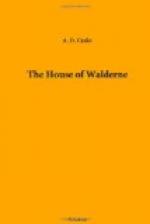In a former story, the Andredsweald, a tale of the Norman Conquest, he wrote of “The House of Michelham,” in the same locality, and he has introduced one of the descendants of that earlier family, in the person of Friar Martin, thinking it might prove a link of interest to the readers of the earlier story.
He had intended to incorporate more of the general history of the time, but space forbade, so he can only recommend his readers who are curious to know more of the period to the Life of Simon de Montfort, by Canon Creighton {1}, which will serve well to accompany the novelette. And also those who wish to know more of the loving and saintly Francis of Assisi, will find a most excellent biography by Mrs. Oliphant, in Macmillan’s Sunday Library, to which the author also acknowledges great obligations.
If it be objected, as it probably may, that the author’s Franciscans are curiously like the early Wesleyans, or in some respects even like a less respectable body of modern religionists, he can only reply “so they were;” but there was this great difference, that they deeply realised the sacramental system of the Church, and led people to her, not from her; the preacher was never allowed to supersede the priest.
But, on the other hand, it may reasonably be objected that Brother Martin only exhibits one side of the religion of his period; that there is an unaccountable absence of the popular superstitions of the age in his teaching; and that, more especially, he does not invoke the saints as a friar would naturally have done again and again.
Now, the author does not for a moment deny that Martin must have shared in the common belief of his time; but such things were not of the essence of his teaching, only the accidental accompaniments thereof. The prominent feature of the preaching of the early Franciscans was, as was that of St. Paul, Jesus Christ and Him crucified. And in a book intended primarily for young readers of the Church of England, it is perhaps allowable to suppress features which would perplex youthful minds before they have the power of discriminating between the chaff and the wheat; while it is not thereby intended to deny that they really existed. The objectionable side of the teaching of the medieval Church of England has been dwelt upon with such little charity, by certain Protestant writers, that their youthful readers might be led to think that the religion of their forefathers was but a mass of superstition, devoid of all spiritual life, and therefore the author feels that it is better to dwell upon the points of agreement between the fathers and the children, than to gloat over “corruptions.”




